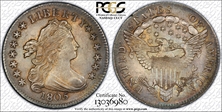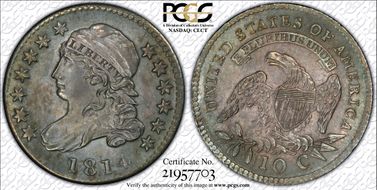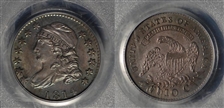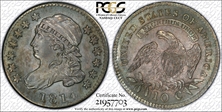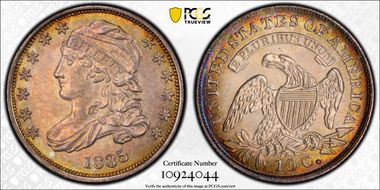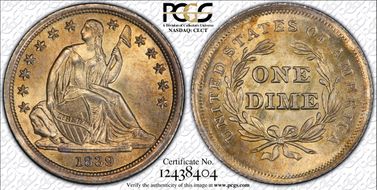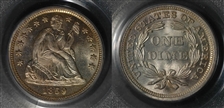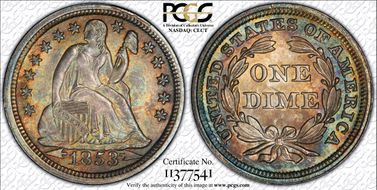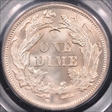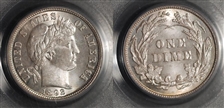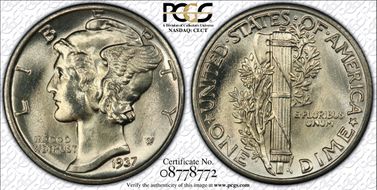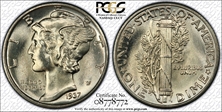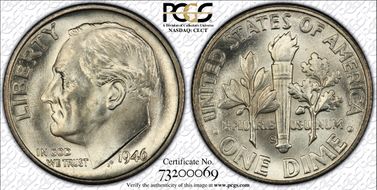Gobrecht's Raisinet Collection 的钱币相册
JR-4. Rarity-4. PQ. A coin with strong eye appeal, reflective fields and frosty devices. A bright and attractive dime that has delicate peripheral gold toning starting to form around the edges, with the centers light silver-gray. The strike was sharp as nearly always seen on 1796 dimes, with strong separation on Liberty's uppermost curls and most of the eagle's breast feathers still surviving. Faint, nearly horizontal adjustment marks can be discerned crossing through Liberty’s central curls and neck. Middle die state with the usual thin crack through the first star to the second curl on Liberty, no signs of clashing, and another crack on the reverse left of first S of STATES. Identifiable by a tiny edge scrape above the eighth star and another above the first A of AMERICA. First year of issue for the denomination, and a two year type coin. The Mint coined its first silver dimes and quarters in 1796, and the first gold quarter eagles made their appearance. In 1796 the new design was employed on all five silver denominations, from half dimes through silver dollars. Many of these new coins and new designs were produced in extremely limited numbers, and the year overall is notable for producing some of the rarest U.S. type coins.
JR-4. Rarity-4. PQ. A coin with strong eye appeal, reflective fields and frosty devices. A bright and attractive dime that has delicate peripheral gold toning starting to form around the edges, with the centers light silver-gray. The strike was sharp as nearly always seen on 1796 dimes, with strong separation on Liberty's uppermost curls and most of the eagle's breast feathers still surviving. Faint, nearly horizontal adjustment marks can be discerned crossing through Liberty’s central curls and neck. Middle die state with the usual thin crack through the first star to the second curl on Liberty, no signs of clashing, and another crack on the reverse left of first S of STATES. Identifiable by a tiny edge scrape above the eighth star and another above the first A of AMERICA. First year of issue for the denomination, and a two year type coin. The Mint coined its first silver dimes and quarters in 1796, and the first gold quarter eagles made their appearance. In 1796 the new design was employed on all five silver denominations, from half dimes through silver dollars. Many of these new coins and new designs were produced in extremely limited numbers, and the year overall is notable for producing some of the rarest U.S. type coins.
1805 10C 4 Berries MS63 JR-2, R.2. The die crack through ERTY and star 8 and the eponymous reverse identify this instantly as an example of the JR-2 4 Berries, and this is a lovely example for the grade. While JR-2 is the more plentiful of the two known die marriages of the 1805 Draped Bust Dime, examples that have survived the passage of time with fully Mint State surfaces must be considered rare. The dimes of 1805 are known only by two die marriages that share a common obverse, with a small spine protruding from the top of the 5 in the date. The reverses show four or five olives on the olive branch clutched by the Heraldic Eagle, or berries as they are usually called, with the present 4 Berries reverse having narrow A's and leaves that are clear of the peripheral lettering. This coin shows appealing medium-gray and golden highlights on each side, with few relevant abrasions. The 1805 4 Berries will never be an uncommon die pairing, but both the 4 Berries and 5 Berries JR-1 are popular Guide Book varieties eagerly sought by collectors, and both are fairly available for a price into the lower Mint State grades. However, Select Uncirculated pieces are scarce and are sought after by both type collectors and Early Dime specialists. The 1805 JR-2 dime is the second most common Draped Bust variety behind the 1807, and both coins are ideal for collectors who want a single example of the draped bust, heraldic eagle design in type set collections. Obverse Die: The 1 nearly touches the lowest curl and the top of the 5 has a spine extending into the bust. LIB are close and BERTY are wide. Star 1 is far from the curl, star 7 is farther from L, star 8 is very close to the Y, and star 13 is close to the bust. State a. Perfect with no crack through ERTY. State b. Cracked from the rim through ERTY. Minor clash marks. State c. Cracked from the rim below star 13 into the bottom of the bust. The die is lapped, removing most of the clash marks. State d. Cracked from the rim between stars 9 and 10 into the bust, about one-third of the distance down from the base of the neck to the bottom of the bust. Reverse Die: Four berries in the branch. All letters in the legend are separated from each other and from the devices. AMER are extremely close together, with AM slightly higher than ER. The star pattern is unusual with two rows of six stars each, and a single star touching the back of the eagle's neck. Stars 1, 2, and 5, touch the clouds above. State a. Perfect. State b Minor die rust near D of UNITED.
1805 10C 4 Berries MS63 JR-2, R.2. The die crack through ERTY and star 8 and the eponymous reverse identify this instantly as an example of the JR-2 4 Berries, and this is a lovely example for the grade. While JR-2 is the more plentiful of the two known die marriages of the 1805 Draped Bust Dime, examples that have survived the passage of time with fully Mint State surfaces must be considered rare. The dimes of 1805 are known only by two die marriages that share a common obverse, with a small spine protruding from the top of the 5 in the date. The reverses show four or five olives on the olive branch clutched by the Heraldic Eagle, or berries as they are usually called, with the present 4 Berries reverse having narrow A's and leaves that are clear of the peripheral lettering. This coin shows appealing medium-gray and golden highlights on each side, with few relevant abrasions. The 1805 4 Berries will never be an uncommon die pairing, but both the 4 Berries and 5 Berries JR-1 are popular Guide Book varieties eagerly sought by collectors, and both are fairly available for a price into the lower Mint State grades. However, Select Uncirculated pieces are scarce and are sought after by both type collectors and Early Dime specialists. The 1805 JR-2 dime is the second most common Draped Bust variety behind the 1807, and both coins are ideal for collectors who want a single example of the draped bust, heraldic eagle design in type set collections. Obverse Die: The 1 nearly touches the lowest curl and the top of the 5 has a spine extending into the bust. LIB are close and BERTY are wide. Star 1 is far from the curl, star 7 is farther from L, star 8 is very close to the Y, and star 13 is close to the bust. State a. Perfect with no crack through ERTY. State b. Cracked from the rim through ERTY. Minor clash marks. State c. Cracked from the rim below star 13 into the bottom of the bust. The die is lapped, removing most of the clash marks. State d. Cracked from the rim between stars 9 and 10 into the bust, about one-third of the distance down from the base of the neck to the bottom of the bust. Reverse Die: Four berries in the branch. All letters in the legend are separated from each other and from the devices. AMER are extremely close together, with AM slightly higher than ER. The star pattern is unusual with two rows of six stars each, and a single star touching the back of the eagle's neck. Stars 1, 2, and 5, touch the clouds above. State a. Perfect. State b Minor die rust near D of UNITED.
1814 10C Large Date MS64. JR-3, R.2. The obverse has normal stars without repunching on stars 3, 4, and 5. This die variety is distinguishable by the low curl extending to the right edge of the second 1 in the date, and the lack of the period after the C of 10 C. Somewhat bluntly struck on the hair curls and stars to the right as usual; additional weakness appears on the stars to the left and on the eagle's claws. The dark surfaces are still lustrous, but beneath deep lilac and iridescent green toning. A relatively common variety with a number of Choice or Gem Mint State pieces known, and ideal for the type collector.
1814 10C Large Date MS64. JR-3, R.2. The obverse has normal stars without repunching on stars 3, 4, and 5. This die variety is distinguishable by the low curl extending to the right edge of the second 1 in the date, and the lack of the period after the C of 10 C. Somewhat bluntly struck on the hair curls and stars to the right as usual; additional weakness appears on the stars to the left and on the eagle's claws. The dark surfaces are still lustrous, but beneath deep lilac and iridescent green toning. A relatively common variety with a number of Choice or Gem Mint State pieces known, and ideal for the type collector.
1814 10C Large Date MS64. JR-3, R.2. The obverse has normal stars without repunching on stars 3, 4, and 5. This die variety is distinguishable by the low curl extending to the right edge of the second 1 in the date, and the lack of the period after the C of 10 C. Somewhat bluntly struck on the hair curls and stars to the right as usual; additional weakness appears on the stars to the left and on the eagle's claws. The dark surfaces are still lustrous, but beneath deep lilac and iridescent green toning. A relatively common variety with a number of Choice or Gem Mint State pieces known, and ideal for the type collector.
1835 10C MS64 PCGS. JR-9, R.2. A gloriously toned, Choice Uncirculated example of this popular dime, this is a well centered and sharply struck late-date, Capped Bust coin. It has an attractive periphery of sea-green and gold toning that has accumulated over the years and beautifully circles and frames the sharply impressed centers on each side. Fancy 8 in date, with diagnostic Large 3 in the date repunched southeast. The 5 is high and has a curved flag. The 10th star touches a denticle. On the reverse RI in AMERICA touch, the first A is high and the second T in STATES is entered low.
1835 10C MS64 PCGS. JR-9, R.2. A gloriously toned, Choice Uncirculated example of this popular dime, this is a well centered and sharply struck late-date, Capped Bust coin. It has an attractive periphery of sea-green and gold toning that has accumulated over the years and beautifully circles and frames the sharply impressed centers on each side. Fancy 8 in date, with diagnostic Large 3 in the date repunched southeast. The 5 is high and has a curved flag. The 10th star touches a denticle. On the reverse RI in AMERICA touch, the first A is high and the second T in STATES is entered low.
A solidly struck and highly lustrous near-Gem, considerably more appealing than the Choice designation would suggest. This is a wonderfully appealing example of this early Seated dime issue, sharply struck with light golden-orange patina over each side. Outstanding eye appeal and practically no visible blemishes.
A solidly struck and highly lustrous near-Gem, considerably more appealing than the Choice designation would suggest. This is a wonderfully appealing example of this early Seated dime issue, sharply struck with light golden-orange patina over each side. Outstanding eye appeal and practically no visible blemishes.
Low Mintage and Conditionally Scarce 1859 Seated Liberty Dime MS65. Just 430,000 Seated Dimes emerged from the Philadelphia Mint in 1859, and the issue is only considered common in grades below VF. A semi-prooflike Gem, both sides are noticeably reflective in the fields with some striations (as produced) evident on the obverse. Both sides are bright with minimal golden tinting and a sharp overall appearance. There are remarkably few distractions, as befits the technical grade that has been assigned.
1853 10C Arrows MS65. A Gem example of this silver type, only minted during the years 1853-55 due to the revaluation of silver as a result of the immense hoards of newfound California gold. In the early 1850s, with an excessive quantity of gold in the financial markets, the value of silver increased to the point that the metal value of silver coins was greater than the face value. This led to hoarding and mass melting of these coins. To resolve the problem, legislation was passed by Congress to reduce the weight of the half dimes, dimes, quarters, and half dollars. When the weight of silver coins was reduced in 1853, it was designated by small arrowheads placed on either side of the date to alert the general populace of this weight reduction. This caused two things to occur: first, the old (heavier) coins were widely melted, and second, the new (lighter) coins were saved in relatively large numbers because of the noticeable design alteration. This piece is a superior Gem example of this popular and short-lived, first-year Arrows design. The surfaces are smooth, the strike is razor sharp, and the devices are sharply impressed throughout. There are no significant abrasions, and the luster is thick but slightly subdued under the patina. The surfaces are bursting with a swirling mixture of orange-gold, turquiose and pale lavender toning that permeates both sides and is well balanced on each side, and highlights the central devices with peripheral halos of color. Even though a few dozen Arrows dimes have been certified by the major grading services at higher levels, it would be hard to surpass the eye appeal of this outstanding type coin. This is a simply gorgeous Gem that will endear itself to anyone who appreciates colorful, originally toned coins. Although a high mintage issue, the Arrows, Stars Obverse was only coined for three years, and examples of this exceptional quality remain scarce.
1853 10C Arrows MS65. A Gem example of this silver type, only minted during the years 1853-55 due to the revaluation of silver as a result of the immense hoards of newfound California gold. In the early 1850s, with an excessive quantity of gold in the financial markets, the value of silver increased to the point that the metal value of silver coins was greater than the face value. This led to hoarding and mass melting of these coins. To resolve the problem, legislation was passed by Congress to reduce the weight of the half dimes, dimes, quarters, and half dollars. When the weight of silver coins was reduced in 1853, it was designated by small arrowheads placed on either side of the date to alert the general populace of this weight reduction. This caused two things to occur: first, the old (heavier) coins were widely melted, and second, the new (lighter) coins were saved in relatively large numbers because of the noticeable design alteration. This piece is a superior Gem example of this popular and short-lived, first-year Arrows design. The surfaces are smooth, the strike is razor sharp, and the devices are sharply impressed throughout. There are no significant abrasions, and the luster is thick but slightly subdued under the patina. The surfaces are bursting with a swirling mixture of orange-gold, turquiose and pale lavender toning that permeates both sides and is well balanced on each side, and highlights the central devices with peripheral halos of color. Even though a few dozen Arrows dimes have been certified by the major grading services at higher levels, it would be hard to surpass the eye appeal of this outstanding type coin. This is a simply gorgeous Gem that will endear itself to anyone who appreciates colorful, originally toned coins. Although a high mintage issue, the Arrows, Stars Obverse was only coined for three years, and examples of this exceptional quality remain scarce.
1887 10C MS66. Cobalt-blue, gray, and lavender toning dances over lustrous surfaces. Well struck, except for the hair on Liberty's head and the bow knot. No major blemishes are apparent.
1887 10C MS66. Cobalt-blue, gray, and lavender toning dances over lustrous surfaces. Well struck, except for the hair on Liberty's head and the bow knot. No major blemishes are apparent.
1874 10C Arrows MS66. Light orange toning visits the primarily silver-white surfaces. This Premium Gem is lustrous and well struck, and both sides are splendidly unabraded. The second and final year of the Arrows, Legend Obverse subtype. Housed in a green label holder.
1874 10C Arrows MS66. Light orange toning visits the primarily silver-white surfaces. This Premium Gem is lustrous and well struck, and both sides are splendidly unabraded. The second and final year of the Arrows, Legend Obverse subtype. Housed in a green label holder.
1937 10C MS67FB. Adolph A. Weinman's Winged Liberty head or "Mercury" design made its debut as part of the coinage revolution that swept the dime, quarter, and half dollar in 1916. This classic design was used on the dime, and the obverse depicted a portrait of Liberty modeled after Elsie Stevens. Liberty wears a winged cap which symbolizes freedom of thought, but she was soon confused with the Roman god Mercury, and the name has been with her ever since. A fasces with an olive sprig dominates the reverse. Production quality was consistently excellent on this 1937 issue of more than 56 million pieces, so it is not surprising that many Superb Full Bands examples survive today. But even for an issue that is known for high quality survivors, this Superb Gem is as well preserved as one would expect from the grade, offering thick mint frost in generous proportions on each side, along with a bold strike and a near-total lack of contact evidence. Glowing luster radiates from the near-pristine, snow-white surfaces. The dazzling, untoned surfaces are strongly detailed and look almost as they did when made. Sharply struck, the all-important central bands are well defined. The only contact mark is a tiny nick in the field on the reverse, above and to the right of the O in ONE.
1937 10C MS67FB. Adolph A. Weinman's Winged Liberty head or "Mercury" design made its debut as part of the coinage revolution that swept the dime, quarter, and half dollar in 1916. This classic design was used on the dime, and the obverse depicted a portrait of Liberty modeled after Elsie Stevens. Liberty wears a winged cap which symbolizes freedom of thought, but she was soon confused with the Roman god Mercury, and the name has been with her ever since. A fasces with an olive sprig dominates the reverse. Production quality was consistently excellent on this 1937 issue of more than 56 million pieces, so it is not surprising that many Superb Full Bands examples survive today. But even for an issue that is known for high quality survivors, this Superb Gem is as well preserved as one would expect from the grade, offering thick mint frost in generous proportions on each side, along with a bold strike and a near-total lack of contact evidence. Glowing luster radiates from the near-pristine, snow-white surfaces. The dazzling, untoned surfaces are strongly detailed and look almost as they did when made. Sharply struck, the all-important central bands are well defined. The only contact mark is a tiny nick in the field on the reverse, above and to the right of the O in ONE.
1946-S 10C MS67. A highly lustrous example from the first year of issue, precisely struck and highly attractive. Roosevelt dime collectors know that the early S-mint dates are the most desirable issues in the series.
1946-S 10C MS67. A highly lustrous example from the first year of issue, precisely struck and highly attractive. Roosevelt dime collectors know that the early S-mint dates are the most desirable issues in the series.























